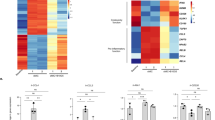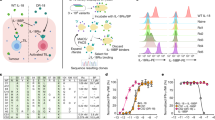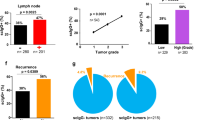Abstract
Interleukin (IL)-15 plays an important role in natural killer (NK) and CD8+ T-cell proliferation and function and is more effective than IL-2 for tumor immunotherapy. The trans-presentation of IL-15 by neighboring cells is more effective for NK cell activation than its soluble IL-15. In this study, the fusion protein dsNKG2D–IL-15, which consisted of two identical extracellular domains of human NKG2D coupled to human IL-15 via a linker, was engineered in Escherichia coli. DsNKG2D–IL-15 could efficiently bind to major histocompatibility complex class I chain-related protein A (MICA) of human tumor cells with the two NKG2D domains and trans-present IL-15 to NK or CD8+ T cells. We transplanted human gastric cancer (SGC-7901) cells into nude mice and mouse melanoma cells with ectopic expression of MICA (B16BL6–MICA) into C57BL/6 mice. Then, we studied the anti-tumor effects mediated by dsNKG2D–IL-15 in the two xenografted tumor models. Human dsNKG2D–IL-15 exhibited higher efficiency than IL-15 in suppressing gastric cancer growth. Exogenous human dsNKG2D–IL-15 was centrally distributed in the mouse tumor tissues based on in vivo live imaging. The frequencies of human CD56+ cells infiltrated into the tumor tissues following the injection of peripheral blood mononuclear cells into nude mice bearing human gastric cancer were significantly increased by human dsNKG2D–IL-15 treatment. Human dsNKG2D–IL-15 also delayed the growth of transplanted melanoma (B16BL6–MICA) by activating and recruiting mouse NK and CD8+ T cells. The anti-melanoma effect of human dsNKG2D–IL-15 in C57BL/6 mice was mostly decreased by the in vivo depletion of mouse NK cells. These data highlight the potential use of human dsNKG2D–IL-15 for tumor therapy.
This is a preview of subscription content, access via your institution
Access options
Subscribe to this journal
Receive 12 digital issues and online access to articles
$119.00 per year
only $9.92 per issue
Buy this article
- Purchase on Springer Link
- Instant access to full article PDF
Prices may be subject to local taxes which are calculated during checkout







Similar content being viewed by others
References
Steel JC, Waldmann TA, Morris JC . Interleukin-15 biology and its therapeutic implications in cancer. Trends Pharmacol Sci 2012; 33: 35–41.
Jakobisiak M, Golab J, Lasek W . Interleukin 15 as a promising candidate for tumor immunotherapy. Cytokine Growth Factor Rev 2011; 22: 99–108.
Sanjabi S, Mosaheb MM, Flavell RA . Opposing effects of TGF-beta and IL-15 cytokines control the number of short-lived effector CD8+ T cells. Immunity 2009; 31: 131–144.
Tao Q, Chen T, Tao L, Wang H, Pan Y, Xiong S et al. IL-15 improves the cytotoxicity of cytokine-induced killer cells against leukemia cells by upregulating CD3+CD56+ cells and downregulating regulatory T cells as well as IL-35. J Immunother 2013; 36: 462–467.
Berger C, Berger M, Hackman RC, Gough M, Elliott C, Jensen MC et al. Safety and immunologic effects of IL-15 administration in nonhuman primates. Blood 2009; 114: 2417–2426.
Imamura M, Shook D, Kamiya T, Shimasaki N, Chai SM, Coustan-Smith E et al. Autonomous growth and increased cytotoxicity of natural killer cells expressing membrane-bound interleukin-15. Blood 2014; 124: 1081–1088.
Yiang GT, Chou RH, Chang WJ, Wei CW, Yu YL . Long-term expression of rAAV2-hIL15 enhances immunoglobulin production and lymphokine-activated killer cell-mediated human glioblastoma cell death. Mol Clin Oncol 2013; 1: 321–325.
Zhao DX, Li ZJ, Zhang Y, Zhang XN, Zhao KC, Li YG et al. Enhanced antitumor immunity is elicited by adenovirus-mediated gene transfer of CCL21 and IL-15 in murine colon carcinomas. Cell Immunol 2014; 289: 155–161.
Bessard A, Solé V, Bouchaud G, Quéméner A, Jacques Y . High antitumor activity of RLI, an interleukin-15 (IL-15)-IL-15 receptor alpha fusion protein, in metastatic melanoma and colorectal cancer. Mol Cancer Ther 2009; 8: 2736–2745.
Kermer V, Baum V, Hornig N, Kontermann RE, Müller D . An antibody fusion protein for cancer immunotherapy mimicking IL-15 trans-presentation at the tumor site. Mol Cancer Ther 2012; 11: 1279–1288.
Cheever MA . Twelve immunotherapy drugs that could cure cancers. Immunol Rev 2008; 222: 357–368.
Müller JR, Waldmann TA, Kruhlak MJ, Dubois S . Paracrine and trans-presentation functions of IL-15 are mediated by diverse splice versions of IL-15Rα in human monocytes and dendritic cells. J Biol Chem 2012; 287: 40328–40338.
Lucas M, Schachterle W, Oberle K, Aichele P, Diefenbach A . Dendritic cells prime natural killer cells by trans-presenting interleukin 15. Immunity 2007; 26: 503–517.
Castillo EF, Schluns KS . Regulating the immune system via IL-15 trans-presentation. Cytokine 2012; 59: 479–490.
Huntington ND, Alves NL, Legrand N, Lim A, Strick-Marchand H, Mention JJ et al. IL-15 trans-presentation promotes both human T-cell reconstitution and T-cell-dependent antibody responses in vivo. Proc Natl Acad Sci USA 2011; 108: 6217–6222.
Kobayashi H, Dubois S, Sato N, Sabzevari H, Sakai Y, Waldmann TA et al. Role of trans-cellular IL-15 presentation in the activation of NK cell-mediated killing, which leads to enhanced tumor immunosurveillance. Blood 2005; 105: 721–727.
Stoklasek TA, Schluns KS, Lefrançois L . Combined IL-15/IL-15Ralpha immunotherapy maximizes IL-15 activity in vivo. J Immunol 2006; 177: 6072–6080.
Dubois S, Patel HJ, Zhang M, Waldmann TA, Müller JR . Preassociation of IL-15 with IL-15R alpha-IgG1-Fc enhances its activity on proliferation of NK and CD8+/CD44high T cells and its antitumor action. J Immunol 2008; 180: 2099–2106.
Waldmann TA, Conlon KC, Stewart DM, Worthy TA, Janik JE, Fleisher TA et al. Phase 1 trial of IL-15 trans presentation blockade using humanized Mikβ1 mAb in patients with T-cell large granular lymphocytic leukemia. Blood 2013; 121: 476–484.
Bouchaud G, Garrigue-Antar L, Solé V, Quéméner A, Boublik Y, Mortier E et al. The exon-3-encoded domain of IL-15R alpha contributes to IL-15 high-affinity binding and is crucial for the IL-15 antagonistic effect of soluble IL-15Ralpha. J Mol Biol 2008; 382: 1–12.
Ullrich E, Koch J, Cerwenka A, Steinle A . New prospects on the NKG2D/NKG2DL system for oncology. Oncoimmunology 2013; 2: e26097 .
Wu J, Song Y, Bakker AB, Bauer S, Spies T, Lanier LL et al. An activating immunoreceptor complex formed by NKG2D and DAP10. Science 1999; 285: 730–732.
Hayakawa Y . Targeting NKG2D in tumor surveillance. Expert Opin Ther Targets 2012; 16: 587–599.
Salih HR, Holdenrieder S, Steinle A . Soluble NKG2D ligands: prevalence, release, and functional impact. Front Biosci 2008; 13: 3448–3456.
Zhang T, Sentman CL . Cancer immunotherapy using a bispecific NK receptor fusion protein that engages both T cells and tumor cells. Cancer Res 2011; 71: 2066–2076.
Xia Y, Chen B, Shao X, Xiao W, Qian L, Ding Y et al. Treatment with a fusion protein of the extracellular domains of NKG2D to IL-15 retards colon cancer growth in mice. J Immunother 2014; 37: 257–266.
Gong W, Xiao W, Hu M, Weng X, Qian L, Pan X et al. Ex vivo expansion of natural killer cells with high cytotoxicity by K562 cells modified to co-express major histocompatibility complex class I chain-related protein A, 4-1BB ligand, and interleukin-15. Tissue Antigens 2010; 76: 467–475.
Lin Z, Wang C, Xia H, Liu W, Xiao W, Qian L et al. CD4(+) NKG2D(+) T cells induce NKG2D down-regulation in natural killer cells in CD86-RAE-1ε transgenic mice. Immunology 2014; 141: 401–415.
Mrózek E, Anderson P, Caligiuri MA . Role of interleukin-15 in the development of human CD56+ natural killer cells from CD34+ hematopoietic progenitor cells. Blood 1996; 87: 2632–2640.
Barao I, Alvarez M, Redelman D, Weiss JM, Ortaldo JR, Wiltrout RH et al. Hydrodynamic delivery of human IL-15 cDNA increases murine natural killer cell recovery after syngeneic bone marrow transplantation. Biol Blood Marrow Transplant 2011; 17: 1754–1764.
Bauer S, Groh V, Wu J, Steinle A, Phillips JH, Lanier LL et al. Activation of NK cells and T cells by NKG2D, a receptor for stress-inducible MICA. Science 1999; 285: 727–729.
Cerwenka A, Baron JL, Lanier LL . Ectopic expression of retinoic acid early inducible-1 gene (RAE-1) permits natural killer cell-mediated rejection of a MHC class I-bearing tumor in vivo. Proc Natl Acad Sci USA 2001; 98: 11521–11526.
Diefenbach A, Jensen ER, Jamieson AM, Raulet DH . Rae1 and H60 ligands of the NKG2D receptor stimulate tumour immunity. Nature 2001; 413: 165–171.
Zhang J, Xu Z, Zhou X, Zhang H, Yang N, Wu Y et al. Loss of expression of MHC class I-related chain A (MICA) is a frequent event and predicts poor survival in patients with hepatocellular carcinoma. Int J Clin Exp Pathol 2014; 7: 3123–3231.
Chitadze G, Lettau M, Bhat J, Wesch D, Steinle A, Fürst D et al. Shedding of endogenous MHC class I-related chain molecules A and B from different human tumor entities: heterogeneous involvement of the “a disintegrin and metalloproteases” 10 and 17. Int J Cancer 2013; 133: 1557–1566.
Kaiser BK, Yim D, Chow IT, Gonzalez S, Dai Z, Mann HH et al. Disulphide-isomerase-enabled shedding of tumor-associated NKG2D ligands. Nature 2007; 447: 482–486.
Chitadze G, Bhat J, Lettau M, Janssen O, Kabelitz D . Generation of soluble NKG2D ligands: proteolytic cleavage, exosome secretion and functional implications. Scand J Immunol 2013; 78: 120–129.
Dai Z, Turtle CJ, Booth GC, Riddell SR, Gooley TA, Stevens AM et al. Normally occurring NKG2D+CD4+ T cells are immunosuppressive and inversely correlated with disease activity in juvenile-onset lupus. J Exp Med 2009; 206: 793–805.
Groh V, Smythe K, Dai Z, Spies T . Fas-ligand-mediated paracrine T cell regulation by the receptor NKG2D in tumor immunity. Nat Immunol 2006; 7: 755–762.
Zhang C, Zhang J, Niu J, Zhang J, Tian Z . Interleukin-15 improves cytotoxicity of natural killer cells via up-regulating NKG2D and cytotoxic effector molecule expression as well as STAT1 and ERK1/2 phosphorylation. Cytokine 2008; 42: 128–136.
Soriani A, Zingoni A, Cerboni C, Iannitto ML, Ricciardi MR, Di Gialleonardo V et al. ATM-ATR-dependent up-regulation of DNAM-1 and NKG2D ligands on multiple myeloma cells by therapeutic agents results in enhanced NK-cell susceptibility and is associated with a senescent phenotype. Blood 2009; 113: 3503–3511.
Diermayr S, Himmelreich H, Durovic B, Mathys-Schneeberger A, Siegler U, Langenkamp U et al. NKG2D ligand expression in AML increases in response to HDAC inhibitor valproic acid and contributes to allorecognition by NK-cell lines with single KIR-HLA class I specificities. Blood 2008; 111: 1428–1436.
Bouchaud G, Gehrke S, Krieg C, Kolios A, Hafner J, Navarini AA et al. Epidermal IL-15Rα acts as an endogenous antagonist of psoriasiform inflammation in mouse and man. J Exp Med 2013; 210: 2105–2117.
Wendel M, Galani IE, Suri-Payer E, Cerwenka A . Natural killer cell accumulation in tumors is dependent on IFN-gamma and CXCR3 ligands. Cancer Res 2008; 68: 8437–8445.
González S, Groh V, Spies T . Immunobiology of human NKG2D and its ligands. Curr Top Microbiol Immunol 2006; 298: 121–138.
Giri JG, Kumaki S Ahdieh M Friend DJ, Loomis A, Shanebeck K et al. Identification and cloning of a novel IL-15 binding protein that is structurally related to the alpha chain of the IL-2 receptor. EMBO J 1995; 14: 3654–3663.
Raulet DH, Gasser S, Gowen BG, Deng W, Jung H . Regulation of ligands for the NKG2D activating receptor. Annu Rev Immunol 2013; 31: 413–441.
Acknowledgements
This work was supported by the National Natural Science Foundation (nos. 81172785 and 81471547), the Natural Science Fund of Jiangsu Province (BK2011449 and BK2008215), and the collaborative fund of Yangzhou University and Yangzhou municipality (2012038-5).
Author information
Authors and Affiliations
Ethics declarations
Competing interests
All authors have declared there are no financial conflicts of interest with regard to this work.
Additional information
Supplementary information of this article can be found on the Cellular & Molecular Immunology's website (http://www.nature.com/cmi).
Supplementary information
Rights and permissions
About this article
Cite this article
Chen, Y., Chen, B., Yang, T. et al. Human fused NKG2D–IL-15 protein controls xenografted human gastric cancer through the recruitment and activation of NK cells. Cell Mol Immunol 14, 293–307 (2017). https://doi.org/10.1038/cmi.2015.81
Received:
Revised:
Accepted:
Published:
Issue Date:
DOI: https://doi.org/10.1038/cmi.2015.81
Keywords
This article is cited by
-
Immunology and immunotherapy in gastric cancer
Clinical and Experimental Medicine (2023)
-
IL-15-induced lymphocytes as adjuvant cellular immunotherapy for gastric cancer
Investigational New Drugs (2021)
-
Immune checkpoint molecules in natural killer cells as potential targets for cancer immunotherapy
Signal Transduction and Targeted Therapy (2020)
-
Regulatory NK1.1−CD4+NKG2D+ subset induced by NKG2DL+ cells promotes tumor evasion in mice
Cancer Immunology, Immunotherapy (2018)
-
Increased expression of programmed cell death protein 1 on NK cells inhibits NK-cell-mediated anti-tumor function and indicates poor prognosis in digestive cancers
Oncogene (2017)



